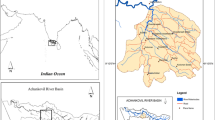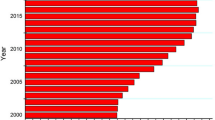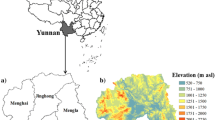Abstract
Rubber plantation is the major land use type in Southeast Asia. Monitoring the spatial-temporal pattern of rubber plantation is significant for regional land resource development, eco-environmental protection, and maintaining border security. With remote sensing technologies, we analyzed the rubber distribution pattern and spatial-temporal dynamic; with GIS and a newly proposed index of Planted Intensity (PI), we further quantified the impacts and limits of topographical factors on rubber plantation in the border region of China, Laos and Myanmar (BRCLM) between 1980 and 2010. The results showed that: (1) As the dominant land use type in this border region, the acreage of rubber plantation was 6014 km2 in 2010, accounting for 8.17% of the total area. Viewing from the rubber plantation structure, the ratio of mature- (≥10 year) and young rubber plantation (<10 year) was 5:7. (2) From 1980 to 2010, rubber plantation expanded significantly in BRCLM, from 705 km2 to 6014 km2, nearly nine times. The distribution characteristics of rubber plantation varied from concentrated toward dispersed, from border inside to outside, and expanded further in all directions with Jinghong City as the center. (3) Restricted by the topographical factors, more than 4/5 proportion of rubber plantation concentrated in the appropriate elevation gradients between 600 and 1000 m, rarely occurred in elevations beyond 1200 m in BRCLM. Nearly 2/3 of rubber plantation concentrated on slopes of 8°–25°, rarely distributed on slopes above 35°. Rubber plantation was primarily distributed in south and east aspects, relatively few in north and west aspects. Rubber planted intensity displayed the similar distribution trend. (4) Comparative studies of rubber plantation in different countries showed that there was a remarkable increase in area at higher elevations and steeper slopes in China, while there were large appropriate topographical gradients for rubber plantation in Laos and Myanmar which benefited China for rubber trans-boundary expansion. (5) Rubber plantation in BRCLM will definitely expend cross borders of China to the territories of Laos and Myanmar, and the continuous expansion in the border region of China will be inevitable.
Similar content being viewed by others
References
Chen S M, Li Y M, 2000. Study on the traffic network system of international subregional cooperation of the connective part of the China, Laos, Burma and Thailand. Economic Geography, 20(6): 84–87. (in Chinese)
Department of Commerce of Yunnan (DCY), 2009. Deputy Director Li Jiming attended the activities of alternative development. Available, 2012-11-28. (in Chinese)
Ekadinata A, Widayati A, Vincent G, 2004. Rubber agroforest identification using object-based classification in Bungo District, Jambi, Indonesia. Chiang Mai, Thailand.
Fox J, 2009. Crossing borders, changing landscapes: Land-use dynamics in the Golden Triangle. 92. Honolulu: East-West Center, 1–8.
Fox J, Vogler J B, 2005. Land-use and land-cover change in montane mainland southeast Asia. Environmental Management, 36(3): 394–403.
IRSG, 2011. Rubber Statistical Bulletin. Singapore: International Rubber Study Group.
Jia K X, Zheng Z, Zhang Y P, 2006. Changes of rubber plantation aboveground biomass along elevation gradient in Xishuangbanna. Chinese Journal of Ecology, 25(9): 1028–1032. (in Chinese)
Kummer D M, Turner II B L, 2007. The human causes of deforestation in Southeast Asia. Bioscience, 44(5): 323–328.
Li H M, Aide T M, Ma Y X et al., 2007. Demand for rubber is causing the loss of high diversity rain forest in SW China. Biodiversity and Conservation, 16(6): 1731–1745.
Li Y F, Liu G H, Huang C, 2011. Analysis of distribution characteristics of Hevea brasiliensis in the Xishuangbanna area based on HJ-1 satellite data. Science China Information Sciences, 41(Suppl.): 166–176.
Li Z, Fox J M, 2012. Mapping rubber tree growth in mainland Southeast Asia using time-series MODIS 250m NDVI and statistical data. Applied Geography, 32(2): 420–432.
Li Z J, Ma Y X, Li H M et al., 2008. Relation of land use and cover change to topography in Xishuangbanna, Southwest China. Journal of Plant Ecology Chinese Version, 32(5): 1091–1103.
Liu H J, Lan H X, Zhang J et al., 2010. Evaluation and analysis for the substitution planting for opium poppy in the north of Laos based on remote sensing. Resources Science, 32(7): 1425–1432. (in Chinese)
Liu S J, Zhang J H, He Z W et al., 2010. Object oriented estimation of rubber plant area using remote sensing data. Guangdong Agricultural Sciences, (1): 168–170.
Liu X N, Feng Z M, Jiang L G et al., 2012. Rubber plantations in Xishuangbanna: Remote sensing identification and digital mapping. Resources Science, 34(9): 1769–1780. (in Chinese)
Manivong V, Cramb R A, 2007. Economics of smallholder rubber expansion in Northern Laos. Agroforest Syst, 74: 113–125.
Ministry of Foreign Affairs of People’s Republic of China (MFA of PRC), 2011. Agreement on the border crossings and its management system between the government of the People’s Republic of China and the government of the Lao People’s Democratic Republic. (in Chinese)
Ministry of Water Resources of the People’s Republic of China (MWR of PRC), 1997. Standards for Classification and Gradation of Soil Erosion. Beijing: China Water Power Press. (in Chinese)
Mo Y Y, Yang L, 2011. Natural rubber’s dynamics of production and sales in 2010 and supply and demand forecast in 2011. China Tropical Agriculture, (2): 49–53. (in Chinese)
Mon M S, Mizoue N, Htun N Z et al., 2012. Factors affecting deforestation and forest degradation in selectively logged production forest: A case study in Myanmar. Forest Ecology and Management, 267: 190–198.
Paul T C, 2009. The post-opium scenario and rubber in northern Laos: Alternative Western and Chinese models of development. International Journal of Drug Policy, 20(5): 424–430.
Thongmanivong S, Fujita Y, 2006. Recent land use and livelihood transitions in northern Laos. Mountain Research and Development, 26(3): 237–244.
Thongmanivong S, Fujita Y, Khamla P et al., 2009. Agrarian land use transformation in northern Laos: From swidden to rubber. Southeast Asian Studies, 47(3): 330–347.
Tropical Biological Resources Comprehensive Survey of Yunnan (TBRCSY), Chinese Academy of Sciences, 1960. Survey Handbook of Land Suitable for Rubber Plantation. (in Chinese)
Turner M, Wear D, Flamm R, 1996. Land ownership and land-cover change in the southern Appalachian Highlands and the Olympic Peninsula. Ecological Applications, 64: 1150–1172.
UNODC. 2011. World Drug Report 2010.
Wang K, 1982. Altitude issues of rubber plantation in hills and mountains in Xishuangbanna, Yunnan. Yunnan Tropical Corps Technology, (1): 9–14. (in Chinese)
Xishuangbanna Dai Autonomous Prefecture Land Management and Agricultural Zoning Office (XDAPLMAZO), 1986. Xishuangbanna Dai Autonomous Prefecture Comprehensive Agricultural Zoning. (in Chinese)
Yunnan Bureau of Statistics (YBS), National Bureau of Statistics of China Survey Office in Yunnan. Yunnan Statistical Yearbook 2011. Beijing: China Statistics Press. 2011. (in Chinese)
Zhang J H, Tao Z L, Liu S J et al., 2010. Rubber planting acreage calculation in Hainan Island based on TM image. Chinese Journal of Tropical Crops, 31(4): 661–665.
Zhang P F, Xu J C, Wang M X et al., 2006. Spatial and temporal dynamics of rubber plantation and its impacts on tropical forest in Xishuangbanna. Remote Sensing for Land & Resources, 69: 51–55.
Zhou W C, 2001. Impact of land nature slope and sea level elevation on the economic development in the Three Gorges area. Resources and Environment in the Yangtze Basin, 10(1): 15–21. (in Chinese)
Zhou Y F, 2008. Yunnan Rubber Tree Cultivation. Kunming: Yunnan University Press. (in Chinese)
Ziegler A D, Fox J M, Xu J C, 2009. The Rubber Juggernaut. Science, 324: 1024–1025.
Author information
Authors and Affiliations
Corresponding author
Additional information
Foundation: National Natural Science Foundation of China, No.41271117; Strategy of Science and Technology Planning Project of Institute of Geographic Sciences and Natural Resources Research, CAS, No.2012SJ008
Author: Liu Xiaona (1986–), Ph.D Candidate, specialized in the study of land use and land cover change.
Rights and permissions
About this article
Cite this article
Liu, X., Feng, Z., Jiang, L. et al. Rubber plantation and its relationship with topographical factors in the border region of China, Laos and Myanmar. J. Geogr. Sci. 23, 1019–1040 (2013). https://doi.org/10.1007/s11442-013-1060-4
Received:
Accepted:
Published:
Issue Date:
DOI: https://doi.org/10.1007/s11442-013-1060-4




